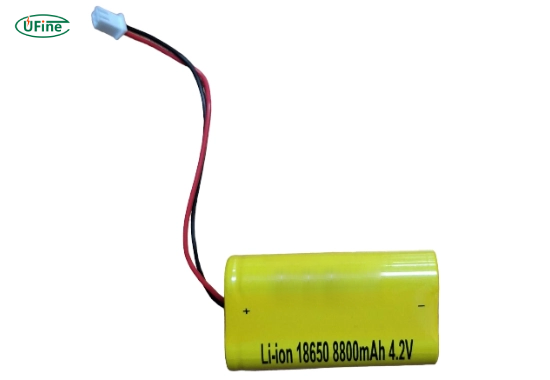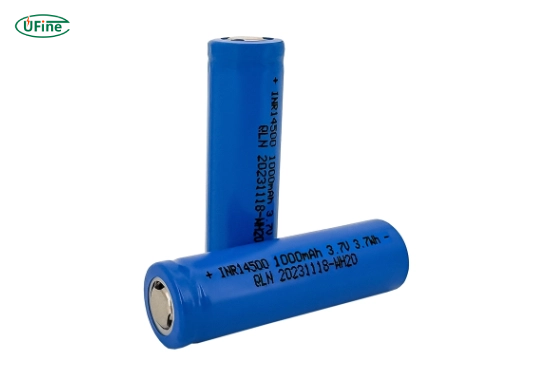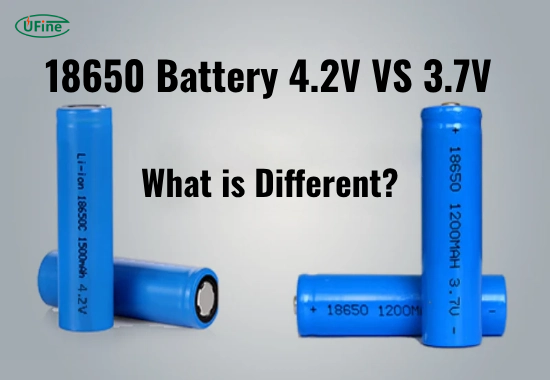18650 batteries are a cornerstone of modern rechargeable technology, powering everything from flashlights to electric vehicles. But what makes 4.2V and 3.7V variants different? Understanding their charging behavior, power output, and optimal applications can help you choose the right battery for your needs. In this guide, we break down these differences, complete with clear examples and practical tips.
Part 1. What is the rated voltage of an 18650 battery?
The rated voltage of an 18650 battery typically refers to its nominal voltage, which commonly comes in two main variants: 3.7 volts and 4.2 volts. This nominal voltage signifies the average voltage level at which the battery operates during its discharge cycle.
The 3.7V variant indicates the average voltage output of the battery throughout its usage. In contrast, the 4.2V variant typically represents the maximum voltage the battery can reach when fully charged. These voltage ratings determine these batteries’ compatible devices and applications.
Understanding the characteristics of 18650 lithium batteries is crucial for selecting the right type of battery. These rechargeable batteries are known for their adaptability, high energy density, and wide range of applications across various devices.
Part 2. 18650 Battery 4.2V
Characteristics
- Voltage Capacity: The distinguishing feature of a 4.2V-rated 18650 battery lies in its higher voltage potential compared to the standard 3.7V version. This variant is engineered to reach a maximum voltage of 4.2 volts when fully charged. The charging and discharging performance differences between the 4.2V and 3.7V variants directly impact their use in high-power applications.
- Increased Power Output: Its elevated voltage capacity enables the battery to deliver higher power outputs, making it suitable for devices demanding substantial energy and sustained high power.
- Charging Specifications: Charging these batteries requires specific chargers capable of managing the higher voltage parameters. Precision charging is essential to maintain battery health and safety.
- Capacity and Efficiency: Despite the higher voltage output, the capacity of the 4.2V-rated 18650 battery often remains similar to its 3.7V counterpart, striking a balance between increased power delivery and adequate energy storage.
Applications
- High-Performance LED Flashlights: High-powered LED flashlights designed for professional use, outdoor adventures, or emergency responders often rely on the extended power delivery of 4.2V-rated 18650 batteries. These batteries sustain the flashlight’s high brightness output for longer durations. This is a prime example of high-performance battery applications, where sustained high output is critical for optimal functionality.
- Electric Bicycles and Scooters: Many electric bicycles and scooters leverage batteries with higher voltage outputs to propel the vehicle efficiently. The 4.2V-rated 18650 batteries provide the necessary power for extended rides and increased performance.
- Portable Power Banks: High-capacity power banks designed for heavy usage, providing sustained power for charging multiple devices, utilizing the enhanced power delivery of 4.2V-rated 18650 batteries, ensuring reliable backup power.
- Vaping Mods: Advanced vaping devices or mods designed for experienced users often require higher power outputs for efficient vaporization. The 4.2V-rated 18650 batteries cater to these devices’ demands for increased energy delivery and extended usage.
- Cordless Power Tools: Power tools such as drills, saws, or screwdrivers that require prolonged usage and substantial power draw benefit from the sustained high-power output of 4.2V-rated batteries, ensuring consistent performance during demanding tasks.
Advantages
- Increased Power Output: The primary advantage lies in the battery’s ability to deliver higher power outputs due to its elevated voltage capacity. This feature caters to devices requiring substantial energy supply and sustained high power.
- Enhanced Device Performance: Devices compatible with these batteries experience improved performance, efficiency, and extended operational times. They operate more effectively, especially during tasks that demand sustained high-power usage.
- Optimized Efficiency: The higher voltage output improves efficiency in power-hungry applications. This efficiency translates to longer runtimes and better overall performance, ensuring devices function optimally.
- Extended Run Times: Devices utilizing 4.2V-rated 18650 batteries benefit from prolonged runtimes due to the batteries’ ability to sustain higher power outputs for extended periods without compromising performance.
- Device Suitability: These batteries cater to devices that accommodate higher voltage ranges. Such devices are engineered to efficiently harness the increased power output efficiently, ensuring optimal performance.
Part 3. 18650 Battery 3.7V
Characteristics
- Nominal Voltage: The defining feature of a 3.7V-rated 18650 battery is its nominal voltage, typically averaging around 3.7 volts. This voltage level represents the average voltage output during the battery’s discharge cycle.
- Stable Power Output: These batteries are engineered to maintain a steady power output within the 3.7V range throughout their usage, providing consistent and reliable energy for various devices.
- Standard Capacity: While the capacity may vary between different models, 3.7V 18650 batteries generally offer a moderate energy storage capacity suitable for powering portable electronic devices.
- Versatility in Usage: Due to their standard voltage and moderate power output, these batteries find widespread use in various consumer electronics, flashlights, and portable devices compatible with their voltage range.
- Compatibility: Devices designed to operate within the 3.7V voltage range efficiently utilize these batteries, ensuring seamless compatibility and stable performance.
- Charging Requirements: Chargers specifically designed for these batteries cater to their voltage and charging requirements, allowing for safe and efficient recharging cycles.
For users looking for a guide on 18650 battery safety, the 3.7V variant offers a stable and reliable choice for devices with lower power demands.
Applications
- Compact Electronics: Due to their moderate voltage output, 3.7V 18650 batteries are well-suited for compact electronic devices like Bluetooth headphones, smartwatches, and small electronic gadgets, balancing power and size.
- Low-Power Flashlights: While high-powered flashlights often lean towards 4.2V batteries, 3.7V variants are commonly used in smaller, everyday carry flashlights, providing ample brightness without excessive power output.
- DIY Electronics Projects: Hobbyists and DIY enthusiasts frequently use 3.7V 18650 batteries in their electronic projects due to their versatility, moderate power, and the ease with which they can be integrated into various circuits.
- Energy-Efficient Sensors: Devices with energy-efficient sensors, such as some environmental monitoring devices or low-power sensors in industrial settings, benefit from the balanced power delivery of 3.7V batteries for prolonged operation.
- Low-Drain Devices: Certain devices, like primary digital clocks, remote controls, or simple electronic toys, operate efficiently with the moderate power supplied by 3.7V batteries, offering extended usage without excessive energy output.
Advantages
- Widespread Compatibility: One of the primary advantages of these batteries is their compatibility with a broad range of devices engineered to operate within the 3.7V voltage range. This versatility ensures their use in various consumer electronics, lighting devices, and DIY projects.
- Standard Voltage: The 3.7V rating represents a standard and widely accepted voltage level, making these batteries readily available and compatible with many devices without requiring specialized engineering or adjustments.
- Moderate Power Output: These batteries offer a balanced power output suitable for devices that require a reasonable energy supply. It is enhancing the battery’s lifespan and device efficiency.
- Stable Performance: With their standardized voltage and moderate power delivery, 3.7V-rated 18650 batteries provide regular and consistent performance in devices designed to use them. This stability ensures reliable power delivery for prolonged usage.
- Versatility in Applications: The balanced power output and widespread compatibility make these batteries versatile, catering to various devices ranging from consumer electronics to portable lighting and DIY projects.
Part 4. What is the difference between 4.2V and 3.7V 18650 batteries?
| Feature | 4.2V 18650 Battery | 3.7V 18650 Battery |
|---|---|---|
| Nominal Voltage | 4.2V (Max Voltage) | 3.7V (Average Voltage) |
| Applications | High-drain devices (e.g., power tools, vaping mods) | Moderate-drain devices (e.g., DIY electronics, small gadgets) |
| Charging Requirements | Special chargers with precise voltage control | Standard lithium-ion chargers |
| Advantages | Higher power output, better for energy-intensive tasks | Greater compatibility, longer lifespan in moderate use |
Voltage Difference
The primary distinction between the 4.2V and 3.7V 18650 batteries is their nominal voltage ratings. The 4.2V variant reaches a maximum voltage of 4.2 volts when fully charged. In comparison, the 3.7V version operates at an average voltage of 3.7 volts throughout its discharge cycle. The charging and discharging performance differences also play a key role in determining how efficient these batteries are in various devices, influencing consumer choices.
Impact on Device Performance and Efficiency
- Higher voltage in the 4.2V battery typically increases power output. Devices utilizing this variant often exhibit enhanced performance and efficiency, especially in applications demanding higher energy delivery.
- The 3.7V battery, with its lower nominal voltage, caters to devices requiring a moderate power supply. While efficient for numerous applications, devices utilizing this variant might achieve a different power-intensive performance than those powered by the 4.2V battery.
Battery Capacity and Output Power Comparison
- The capacity of 4.2V and 3.7V 18650 batteries often remains similar. Both variants offer comparable energy storage and balancing capacity with voltage variance.
- Output power, however, differs significantly. The 4.2V battery delivers higher power output due to its elevated voltage potential, making it suitable for high-drain devices requiring substantial energy.
Effect of Voltage Variance on Battery Lifespan and Device Functionality
- Voltage variance influences battery lifespan and overall device functionality. The higher voltage of the 4.2V battery can lead to increased stress on components and faster depletion if used in devices not designed for its voltage range.
- Conversely, the 3.7V battery, while providing moderate power, might offer better longevity when used in devices optimized for its voltage range, ensuring more balanced stress on components and potentially extending the overall battery lifespan.
Still unsure about which battery suits your needs? Contact us for expert guidance, or explore our full range of 18650 batteries tailored for every application.
Part 5. FAQs
-
What is the difference between 3.7 and 3.6 18650?
The difference in the voltage ratings (3.7V and 3.6V) for 18650 batteries represents their nominal voltages. It indicates the average voltage a battery will provide during its discharge cycle. The actual voltage range can fluctuate depending on charge levels. -
What is the highest output 18650 battery?
The highest output, 18650 batteries, typically vary based on their intended use and specifications. Some high-drain 18650 batteries are designed to deliver high current outputs suitable for devices like high-powered flashlights or vaping mods. -
What is the voltage of a bad 18650 battery?
A “bad” 18650 battery might have a significantly lower voltage than its nominal rating, usually below 3.0 volts. However, the actual voltage indicating a “bad” battery might depend on its condition and usage history. -
Which devices benefit most from 4.2V 18650 batteries?
Devices like high-performance drones, gaming laptops, or portable medical equipment require higher energy output and perform optimally with 4.2V batteries. -
Are 3.7V and 4.2V batteries interchangeable?
Not always. Using the wrong voltage can damage your device. Always check your device specifications to ensure compatibility. -
What voltage should I charge a 3.7V lithium-ion battery?
Lithium-ion batteries labeled as 3.7V nominal voltage typically require charging to around 4.2V, which is the upper limit for safe charging. Setting the voltage beyond this can risk damaging the battery and cause safety hazards.
Related Tags:
More Articles

How to Choose the Best Floor Scrubber Battery for Commercial Cleaning?
Selecting the ideal floor scrubber battery ensures a long runtime, rapid charging, and minimal maintenance for efficient commercial cleaning operations.
Battery for Blower vs Battery for Leaf Vacuum: Which One Should You Choose?
Battery for blower vs leaf vacuum—learn the key differences in power, fit, and runtime to choose the right battery for your outdoor tool needs.
How to Choose the Right Battery for Blower?
Choosing the right blower battery? Consider voltage, capacity, chemistry & usage. This guide helps match the best battery for peak performance.
How to Choose the Best Insulated Battery Box for Lithium Batteries?
Choosing the Best Insulated Battery Box for Lithium Batteries? Discover key factors such as size, material, and safety for optimal protection and performance.
7 Critical Elements on a Lithium Battery Shipping Label
What must be on a lithium battery shipping label? Learn 7 key elements to ensure safety, legal compliance, and correct handling across all transport modes.






